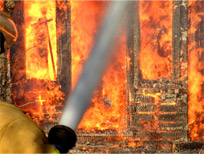|
 What causes more damage more quickly and completely than any other disaster? Fires, they can annihilate your home and possessions in a relatively short time. There are three major strategies to keep your safe from fires – prevention; preparation, by building safety devices and creating procedures in your home to help your family prepare for fires; and lastly, take the steps necessary to react to fires in a safe and helpful way. What causes more damage more quickly and completely than any other disaster? Fires, they can annihilate your home and possessions in a relatively short time. There are three major strategies to keep your safe from fires – prevention; preparation, by building safety devices and creating procedures in your home to help your family prepare for fires; and lastly, take the steps necessary to react to fires in a safe and helpful way.
Step 1: How to Prevent FiresPreventing fires is the first step in fire safety. Practice these fire prevention tips and pass the lessons along to your children and hopefully you will never have to move on to step 3. - Practice electricity safety: Outlets are only meant to handle so much electrical current. Make sure that you don’t overuse your outlets and that all your wires and extension cords are in a good state.
- Install fire extinguishers throughout your home: Fire extinguishers should be in installed in some of the places where fire is most likely to occur. Make sure to train all of your family members on their proper use and mark your calendars to have them charged every year.
- Use candle and fireplace safely: Do not light candles near flammable objects or textiles and be sure to extinguish flames fully before leaving the room. Teach your children not to light candles when they are not in your presence. The same lessons can extend to fireplace use—but make sure you also keep the flue open and clean.
- Teach proper match use: Teach your children that matches are tools for adults only. Never store matches within reach of your children. If you have teens, teach them not to leave matches on paper or other flammable items and instead, to douse them with water before disposing of them.
Step 2: Recognition and PlanningFire prevention isn’t foolproof, so preparation for a fire and proper fire detection is a must. - Install and maintain smoke detectors: You should have several smoke detectors throughout your home. Do not neglect the areas near your bedrooms, even if you don’t think a fire could start there. Because smoke will travel through your home, and is just as dangerous to your life as actual fire, smoke detectors near your bedrooms will help give you an early alert of the problem. Since smoke detectors run on batteries, you will need to monitor the life of the batteries and change them when necessary.
- Define a safe meeting place on the lawn and escape routes: Teach your children the many ways they can get out of your home if it’s on fire and one exit is blocked. Also, teach them what location is a safe distance from the house and choose a central meeting area so that you can ensure everyone’s gotten out safely.
- Test your windows and doors: Make sure all your windows and doors open easily and don’t stick, making it impossible to open them during an emergency. Also, make sure your children are never locked in their rooms. If you have rooms on the second story, consider installing emergency retractable steel ladders.
- Teach your children to dial 911: Whether it’s you or your children who call 911 to get the fire department out to your home doesn’t matter. Teach your children to call 911 if it is safe to do so. Remember, if they can’t call while in your home they can always run to a neighbor’s house and ask them to call.
Step 3: How to Stay Safe during a FireNo matter how hard you try, it is possible that you and your family may experience a fire in your home. If so, keep the following tips in mind. - Stop, drop and roll: This one never gets old, because it works. If your clothing should catch fire, stop what you are doing, drop to the ground and roll around to put the fire out. Then, continue to make your way to safety.
- Avoid smoke inhalation: Smoke inhalation can hurt you as badly as being on fire, so use a wet cloth over your face to avoid inhaling smoke.
- Handle door knobs cautiously: If a closed door stands between you and escape, remember to lightly touch the door handle before grabbing it to open the door. If it is hot, it could be because the fire is worse on the other side of the door and an influx of oxygen from you opening the door could make it worse.
Having home insurance will protect your from the loss incurred from a fire. Call us today to discuss your Los Angeles home insurance options at 323-735-1600.
Posted Thursday, October 18 2012 10:06 AM
Tags : insurance, fire, fire prevention, fire safety, home insurance, homeowners, Los Angeles, California
|